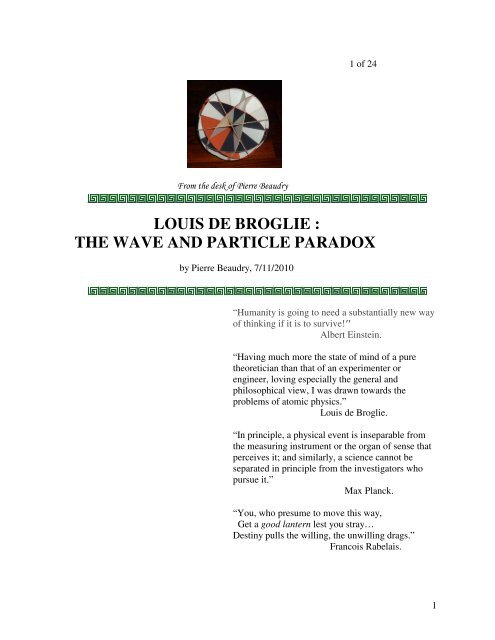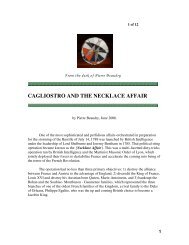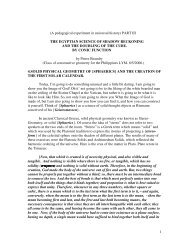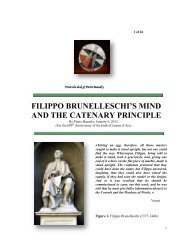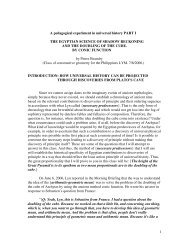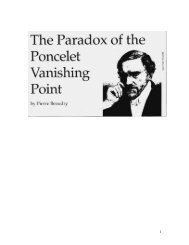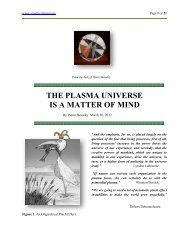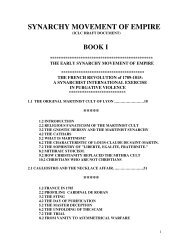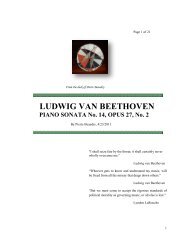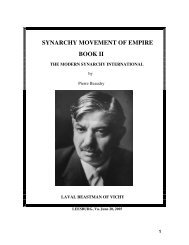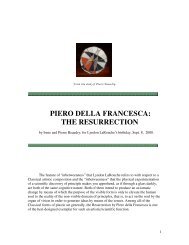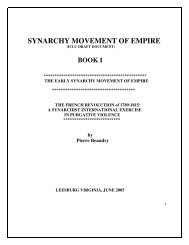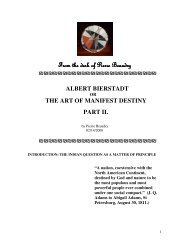LOUIS DE BROGLIE : THE WAVE AND PARTICLE PARADOX
LOUIS DE BROGLIE : THE WAVE AND PARTICLE PARADOX
LOUIS DE BROGLIE : THE WAVE AND PARTICLE PARADOX
Create successful ePaper yourself
Turn your PDF publications into a flip-book with our unique Google optimized e-Paper software.
1 of 24From the desk of Pierre Beaudry<strong>LOUIS</strong> <strong>DE</strong> <strong>BROGLIE</strong> :<strong>THE</strong> <strong>WAVE</strong> <strong>AND</strong> <strong>PARTICLE</strong> <strong>PARADOX</strong>by Pierre Beaudry, 7/11/2010“Humanity is going to need a substantially new wayof thinking if it is to survive!"Albert Einstein.“Having much more the state of mind of a puretheoretician than that of an experimenter orengineer, loving especially the general andphilosophical view, I was drawn towards theproblems of atomic physics.”Louis de Broglie.“In principle, a physical event is inseparable fromthe measuring instrument or the organ of sense thatperceives it; and similarly, a science cannot beseparated in principle from the investigators whopursue it.”Max Planck.“You, who presume to move this way,Get a good lantern lest you stray…Destiny pulls the willing, the unwilling drags.”Francois Rabelais.1
INTRODUCTION: REVIVING <strong>THE</strong> LEAST ACTION PRINCIPLE OF FIn 1924, Louis de Broglie (1892-1987), tackled one of the most difficult scientificproblems that no scientist had been able to solve before him. The mission he undertook was tosolve the wave and particle paradox. Fortunately, it was as a historian, and not as anexperimental physicist, that de Broglie took-up that challenge, because he knew that this problemcould only be solved from the standpoint of the history of ideas and not with the use ofmathematics, or from observations in a laboratory.What de Broglie discovered was a principle that solved a problem representing, at least,three interacting degrees of knowledge. At the first and highest level of epistemology, theproblem involved solving the crisis between the Platonic and Aristotelian methods of consideringthe universe; that is, either what is real in the universe is coherent with the anti-entropicprocesses of the human mind, or what is real is the self-evident object of sense certainty. At thesecond level of scientific knowledge, the problem involved the discovery of a solution to theprofound historical division between two principles of dynamics and of mechanics, that is, thedisparity of a typical Leibniz-Newton incompatibility between the Optics of Pierre de Fermatand the Mechanics of Pierre Louis Maupertuis. At the third and lower experimental level, theproblem to be solved involved two anomalous but parallel conceptions of energy and matter, theparadoxical state of affairs between wave and particle in the process of radiation. De Broglie’sexplicit commitment was to solve this triple layered problem as a matter of principle, byreestablishing the least action principle of Pierre de Fermat and by applying the principle’scongruence of phase with Plank’s Theory of Quanta and Einstein’s Theory of Relativity. This ishow de Broglie formulated his objective in the introduction of his Doctoral Dissertation of 1924:“Guided by the idea of a general relationship between the notions of frequencyand of energy, we acknowledge in the present study the existence of a periodicalphenomenon related to a piece of energy whose nature remains to be clarified as to itsproper mass, and in accordance with the Plank-Einstein equation. The Theory ofRelativity has taught us to associate with any uniform motion of a material point thepropagation of a certain wave whose phase travels in space faster than light. (Ch. I.)In order to generalize that result in the case of a non-uniform motion, we are madeto admit proportionality between the Impulsion of the Universe vector of a material pointwith the characteristic vector of an associated wave propagation whose time componentis established by its frequency. The principle of Fermat applied to the wave, therefore,becomes identical with the principle of least action applied to a moving body. The rays ofthe wave are identical to the possible trajectories of the moving body.” (Louis de Broglie,Recherches sur la Théorie des Quanta, Annales de la fondation Louis de Broglie, Vol.17-N0. 1, 2007, p. 3.) http://tel.archives-ouvertes.fr/docs/00/04/70/78/PDF/tel-00006807.pdfAs I will show in this report, De Broglie identified the principle of least action as the finalcausality principle designed to orient change in all processes of physical spacetime, including thegeneration of singularities. De Broglie went back to Fermat’s idea which defined least action asLeibniz and Bernoulli had done, that is to say, as the pathway of final causality representing the2
easiest and most efficient of all possible pathways that nature chooses to achieve its end. DeBroglie called this principle of proportionality the “harmony of phases” between the wave andthe particle, and he identified this process as the most important discovery of his life.Finally, de Broglie’s treatment of Fermat’s principle of least action can also beconsidered as a method of bootstrap self-generation that is congruent with the principle of ironyin Classical artistic composition. In other words, the discovery of de Broglie includes a forthdegree of knowledge. As I will demonstrate in the last segment of this report, the particle haswithin itself a harmonic ordering principle by means of which its wave overtakes it inharmonically determined places inside of the atom. This process of phase change is analogous tothe phase change process that is generated in the well-tempered musical system of JohannSebastian Bach. As a result of such a process of self-generation, de Broglie was able to developa conception of radiation in which the phase of the wave travels faster that the speed of theelectron particle, therefore, discovering within the atom a singularity of what can only bequalified as a “quantum leap.” Thus, like a voice register shift in Classical singing composition,the harmony of phases of the wave and particle paradox works like a poetical irony simplybecause this is the way the universe is lawfully organized for the mind as well as for matter.1- SOLVING <strong>THE</strong> <strong>WAVE</strong> <strong>AND</strong> <strong>PARTICLE</strong> <strong>PARADOX</strong>Louis de Broglie was 19 years old when he first began to investigate the necessity of awave theory for radiation and for the quanta when he attended the First Solvay Congress of 1911on The Theory of Radiation and the Quanta. This is where he started to work in collaborationwith the French physicist Paul Langevin who had been a student of Pierre Curie and who rapidlybecame the most prominent French representative of Einstein’s Theory of Relativity. At thattime, de Broglie began to consider the design of “unifying the particle and wave points of viewand deepening the true meaning of the quanta.” (De Broglie, Op. Cit., p. 11.)The first conceptual problem that de Broglie had to solve was how to establish aworkable concept of action to replace the notion of energy. This was not simply a question oflanguage or of mathematical formula, but a question of principle. The issue was to reestablish inphysics the authority of the lost universal physical principle of least action of Fermat as afundamental principle of nature. De Broglie knew he could not restitute this idea withoutlaunching a major war that he might lose at the onset. So, he first had to prepare the axiomaticterrain where a harmonically ordered notion of wave action was going to eventually replace thefallacious notion of energy based on the sense-perception of particles. De Broglie noted that onseveral occasions, during the early developments of the theory of Quanta, there had beenattempts to establish a notion of “mechanical action,” but all cases lacked the truthful dynamicsthat were required. As he wrote:“On several occasions there were attempts at giving to the quantum relation anenunciation that would involve action as opposed to energy. Assuredly, the (Planck)constant h has the dimensionality of an action, that is, ML²T-¹, and this is not due tochance, because the Theory of Relativity teaches us to classify action as one of the main3
“invariants” of physics. However, action is a magnitude of a very abstract character and,following numerous meditations on the quanta of light and the photoelectrical effect, wehave been forced to return to the use of energy as a basic notion, until the day we canexplain why action plays such an important role into so many questions.” (De Broglie,Op. Cit., p. 14)Although de Broglie had to accept a momentary set back, he nonetheless established hisfundamental hypothesis for the least action principle, conditionally, as follows:“We can therefore conceive that in accordance with a great Law of Nature, foreach piece of proper mass of energy mo there is related a periodical phenomenon offrequency vo such that we have:hvo = moc²vo being measured, of course, within the system related to the piece of energy. Thishypothesis is the foundation of our system: it is worth what any hypothesis is worth, thevalue of the consequences that can be deduced from it.” (De Broglie, Op. Cit., p. 14)This is how de Broglie restored the Fermat principle of least action in its modernscientific form, but with the provision that he could later change the concept of energy for themore appropriate concept of action. That was de Broglie’s way of applying the principle of leastaction in a very unique form of harmony, as I will show below. Thus, de Broglie developed hishypothesis from the Planck-Einstein equation W = hv where W is the energy, h is the Planckconstant, and v is the frequency of the wave.Then, de Broglie ironically introduced the two opponents of the least action debate,Pierre de Fermat and Pierre Louis Maupertuis, as a way of reflecting the very ambiguity of theissue of wave and particle. Historically, de Broglie dealt with the question as a matter ofproportionality in which Fermat was to the wave as Maupertuis was to the particle. De Brogliewrote:“The principle of Fermat applied to the phase wave is identical with the principlethat Maupertuis applied to a moving body; all of the possible dynamic trajectories of amoving body are identical to those of possible wave rays. We believe that this idea ofequivalence between the two great principles of Optical Geometry and of Dynamicscould be a precious guide for affecting the synthesis between waves and quanta.” (Louisde Broglie, Recherches sur la Théorie des Quanta, Annales de la fondation Louis deBroglie, Vol. 17-N0. 1, 2007, p. 37.) http://tel.archivesouvertes.fr/docs/00/04/70/78/PDF/tel-00006807.pdfThe point is that although de Broglie had made the courageous choice of attempting tosolve the wave and particle paradox, undoubtedly the most difficult paradox of contemporaryscience, according to Einstein, he knew the price he had to pay for telling the truth. He also knewthat the preferred pathway to take with liberals is on the level of principles. In other words, theonly way to come to terms with ambiguities in the domain of physics, as de Broglie did, is toreflect them as ironies of the domain of artistic composition. The poetic necessity in the domainof science is to always choose experiments that reflect the ambiguity of both science and art as a4
product of the same creative process of the mind. It was from this sort of timereversal historicalambiguity that he was able to draw the following conclusion, three years later on the day hereceived the 1929 Nobel Prize for Physics. De Broglie drew the following conclusion:“When I started to ponder these difficulties, two things struck me in the main.Firstly, the light quantum theory cannot be regarded as satisfactory since it defines theenergy of a light corpuscle by the relation W = hv which contains a frequency v. Now, apurely corpuscular theory does not contain any element permitting the definition of afrequency. This reason alone renders it necessary in the case of light to introducesimultaneously the corpuscle concept and the concept of periodicity.On the other hand, the determination of the stable motions of the electrons in theatom involves whole numbers, and so far the only phenomena in which whole numberswere involved in physics were those of interference and of eigenvibrations. Thatsuggested the idea to me that electrons themselves could not be represented as simplecorpuscles either, but that a periodicity had also to be assigned to them.I thus arrived at the following overall concept which guided my studies: for bothmatter and radiation, light in particular, it is necessary to introduce the corpuscle conceptand the wave concept at the same time. In other words, the existence of corpusclesaccompanied by waves has to be assumed in all cases. However, since corpuscles andwaves cannot be independent because, according to Bohr’s expression, they constitutetwo complementary forces of reality, it must be possible to establish a certain parallelismbetween the motion of a corpuscle and the propagation of the associated wave. The firstobjective to achieve had, therefore, to be to establish this correspondence.” (Louis deBroglie, The Wave Nature of the Electron, Nobel Lectures, December 12, 1929.)Thus, if a particle such as an electron could behave as a wave, then, a wave also had tobehave as a particle. Therefore, since the electron had to behave like a wave, de Broglie usedEinstein’s photoelectrical effect to demonstrate that the wavelength associated with the electronhad a ratio of the Plank constant h divided by the momentum of the particle ν; that is, h/ν. Also,when you speak of periodicity, you speak of whole numbers, but when you speak of periodicityof the particle, which is also a wave, you are speaking not just physically, but also poetically:Note, especially, that de Broglie introduced the function of the Plank constant h for the purposeof establishing proportionality between the energy of a particle and the frequency of itselectromagnetic wave. That is where the true poetical ambiguity of the corpuscular and wavestructure resides. What is left of the particle is no longer a thing in itself but a harmonic orderingprocess of change. But, de Broglie took the proportionality a step further.What de Broglie called parallelism was, in reality, an effort at understanding the physicaluniverse from the standpoint of psychophysical parallelism, that is, the relationship between thejudging powers of seeing and hearing, the proportionality between what his vision could nolonger see, but that his musical understanding could hear in the form of harmonically orderedwaves in his mind. This is the way Einstein understood de Broglie’s effort:5
“To arrive at results consistent with the relevant experiments, radiation of a givenfrequency had to be treated as though it consisted of energy atoms of the individualenergy hv where h is Plank’s universal constant. During the years following it was shownthat light was everywhere produced and absorbed in such energy quanta. In particularNiels Bohr was able largely to understand the structure of the atom, on the assumptionthat atoms can have only discrete energy values, and that the discontinuous transitionsbetween them are connected with emission or absorption of such an energy quantum.This threw some light on the fact that in their gaseous state elements and theircompounds radiate and absorb only light of certain sharply defined frequencies. All thiswas quite inexplicable within the frame of the hitherto existing theories. It was clear thatat least in the field of atomistic phenomena the character of everything that happens isdetermined by discrete states and by apparently discontinuous transitions between them,Plank’s constant h playing a decisive role.The next step was taken by de Broglie. He asked himself how the discrete statescould be understood by the aid of current concepts, and hit on a parallel with stationarywaves, as for instance in the case of proper frequencies of organ pipes and strings inacoustics. True, wave actions of the kind here required were unknown; but they could beconstructed, and their mathematical laws formulated, employing Plank’s constant h. DeBroglie conceived an electron revolving about the atomic nucleus as being connectedwith such a hypothetical wave train, and made intelligible to some extent the discretecharacter of Bohr’s “permitted” paths by the stationary character of the correspondingwaves.” (Albert Einstein, The Einstein Reader, CITA<strong>DE</strong>L PRESS BOOKS, KensingtonPublishing Corp., New York, 1956, p. 96.)Thus, the wave-particle paradox was posed and began to be resolved in the minds ofPlank, Einstein, and De Broglie, but it remained an enigmatic puzzle for most of the otherscientists, because they did not understand the subject matter from the level of principles. Thosewere, for all intent and purposes, the only scientists who understood that the universe was basedon universal physical principles, while the fictitious universe of the positivists and empiricistswas based on sense perception, as determined by the probability of statistics.What liberal empiricists did not understand was the poetic principle of irony, theambiguous nature of the phenomenon of wave and particle as a unified conception. For example,the most important idea that de Broglie had discovered was not the wavelength of the electron asmost people were made to believe. His most important discovery was the “accordance ofphases” between the two fundamental aspects of the electron. De Broglie hypothesized that thereexisted between the wave and the particle a “harmony of phases” which reflected the presenceof an internal clock inside of the particle, as he defined it in the first chapter of his 1924 Thesis.The singularity that was expressed by the frequency of the internal clock of the particle lay in thefact that it was the same as the frequency of the wave, but slower than the wave. The slowerphase of the particle was in synchronization with the faster frequency of the wave by a margin ofdiscrepancy that was always harmonically organized in a manner similar to the well-temperedmusical system of Bach; as if it were an analog of the human voice tuned at C-256 cycles perseconds. As a result, de Broglie established the “law of accordance (harmony) of phases” whichstated:6
“For any Galilean observer, the phase of the “internal clock” of the particle is,at each instant equal to the value of the phase of the wave calculated at the same pointat which the particle lies.” (Louis de Broglie, The Wave-particle dualism: a tribute toLouis de Broglie on his 90 th Birthday, edited by Simon Diner, Kluwer AcademicPublishers, 1982, p. 4)The point to be made is that de Broglie’s discovery was not dualism in the sense of NeilsBohr, who believed that under a certain circumstance you get a wave, and under a differentcircumstance you get a particle. The idea is rather that of a permanent coexistence betweenwaves and particles. Contrary to Bohr’s conception, de Broglie hypothesized that there was atrue ambiguity, a unity of ambiguity whereby particles are waves at the same time, and that thewave motion is what determines all the properties of the particles. In other words, the particleand its wave phase are not two different realities. It is the “harmony of phases” which representsthe crucial idea of a stable proportionality between particle and wave. When some form ofdissonance breaks that harmony, a singularity is generated that changes the system. You get aquantum leap. The best understanding of what the underlying “unity of phases” represents wasdescribed by physicist George Lochak who wrote:“The wave-length became famous after the discovery of the diffraction ofmaterial corpuscles and thanks to the preeminent role played by Schrodinger’s equation.But in fact, the forgotten law of phase harmony, which is no longer quoted in textbooks,constitutes the basis of the whole problem of wave-particle dualism and contains, in theopinion of de Broglie, the deep mystery which has to be solved in the first place if one isto understand quantum mechanics. De Broglie never considered that, in stating this law,he had given any explanation of wave-particle dualism: he only found an importantformula which follows from the laws of relativity. But the question is: what property ishidden behind this formula? What is this mysterious balance between corpuscle and wave(similar to the balance between a surf-rider and the sea wave), which is expressed in theformula?” (George Lochak, in Louis de Broglie, The Wave-particle dualism: a tribute toLouis de Broglie on his 90 th Birthday, edited by Simon Diner, Kluwer AcademicPublishers, 1982, p. 4)Lochak did not answer that fundamental question probably because it required goingoutside of mathematics into classical artistic composition. Indeed, think of this process as beingharmonically ordered musically. Look at how the wave and particle of the electron are organizedlike the musical ordering between intervals and notes in a classical composition. Once you beginto think of music in terms of intervals of action as opposed to what the notes represent asparticles, you are on your way to understand the mystery that lies behind or between the notes.Therefore, you must imagine that Mother Nature is playing some great symphonic compositionbetween the particles. That is where the answer lies. So first, go back to the thought experimentthat de Broglie related to in his Thesis:“Take a horizontal circular disk with a very large radius and append to that disk anumber of identical systems formed by a spiral spring to which a weight is attached.Consider that the number of such suspended systems per unity of surface of the plate7
decrease in density very rapidly as you move away from the center and in a manner suchthat there is a condensation of those systems around the center. All of the weight-springsystems are identical and they all have the same periodicity. If you make them oscillatewith the same amplitude and the same phase, the surface going through the center ofgravity of all of those weights will represent a plane that goes up and down in analternating motion. This whole process represents a very rough analogy with the piece ofisolated energy, as I have conceived of it.” (Louis de Broglie, Op. Cit., p. 17.)Figure 1. Harmony of phases between the particle and the wave. From the time it takes for theparticle to go through the trajectory from 0 to 0¹ along the circular pathway, it is overtaken by itsown wave by a full rotation of the circle, because the wave is moving along the spiral pathway ata greater velocity than the particle. (Figure by George Lochak in Louis de Broglie, The Waveparticledualism: a tribute to Louis de Broglie on his 90 th Birthday, edited by Simon Diner,Kluwer Academic Publishers, 1982, p. 5.)By comparison with figure 1, do an analysis situs construction of a harmony of phasesbetween particles and waves using the octave values pertaining to C-256 going through a torus.As in Figure 2, imagine that regular integers express particles and the intervals between themexpress waves. The internal clocks of the particles are measured by regular arithmetic intervalsof one integer at a time, like 1, 2,3,4,5, etc., but the waves are measured by growing intervalswhich are (0)1, (1)2, (12)3, (123)4, (1234)5, etc. Arrange the two types of oscillations of theparticles and the waves in such harmony of phases that all of the wave phases always end upcoinciding with the particle motions, and thus, end up covering all of the empty spaces where theparticles should be in a series totaling 136 waves. That is the sort of bootstrap self-propellingprinciple that de Broglie imagined existed inside of the atomic structure.8
Figure 2. Harmony of phases in a torus with a Poloidal/Toroidal ratio of 3/16.Figure 2 is not a model for de Broglie’s atom. This is a heuristic device showing that byinvestigating a process, you can sometimes discover something else that wasn’t there. And, itmight turn out that what wasn’t there reveals the most important aspect of the principle thatunderlies that process. So, how can we answer Lochak’s question: “What property is hiddenbehind this formula? What is this mysterious balance between corpuscle and wave?” In theabove example, the distribution of the waves and particles of 5 octaves shows that they arehiding a reciprocity function with the constant total of 31, and in which all of the particles aredistributed into sixteen doublets of P/2 waves between each pair of reciprocals. If you rotate theentire system clockwise, you find that the following two series of reciprocities are perfectlybalanced between the Outer and the Inner rims:Inner rimOuter rim.0 + 31 = 31 13 + 18 = 3128 + 3 = 31 30 + 1 = 3124 + 7 = 31 21 + 10 = 3111 + 20 = 31 22 + 9 = 3115 + 16 = 31 29 + 2 = 3112 + 19 = 31 14 + 17 = 318 + 23 = 31 26 + 5 = 3127 + 4 = 31 6 + 25 = 312- <strong>THE</strong> FERMAT LEAST ACTION PRINCIPLEThe idea of understanding shadows is not for the purpose of enjoying entertaining soundor visual effects, but for the purpose of selecting those moments of reality that reflect ironies in amanner that the shadows reveal the presence of a universal physical principle. Then, you must9
identify the principle that casts such a shadow. For instance, look at the shadow of the tear that isshed by the son of Ivan the Terrible in the famous painting of Ilya Repin. What is the principleinvolved? The same sort of ironical process can be identified with the shadow of the particle inthe wave and particle paradox of de Broglie.With that in mind, look at the manner in which de Broglie twists and turns the question ofthe least action principle of Fermat in no less than seven different ways in his 1924 DoctoralDissertation. The point that he keeps making in his 109 pages thesis (at pages 3, 18, 25, 34, 37,61, and 107) is that the mechanical application that Maupertuis made of the least action principleis nothing but a weak shadow of the dynamics of “phase concordance” that Fermat haddeveloped in his least action principle of light propagation.The point to be made is that Maupertuis had subverted the principle of least action ofFermat, Leibniz, and Bernoulli and, instead of applying it to dynamics, he applied it tomechanics. In his discrete fashion, de Broglie generalized the principle and restored it to thedynamics of quanta and relativity. He boldly showed that the application that Maupertuis hadconcocted was a shadow of Fermat’s principle that had so enraged Descartes and the Cartesianson the issue of the moral purpose of final causality. The Cartesians could not understand thatlight was following a design that God had built into it so that it “knew” what direction to takeduring its propagation.I remind briefly the reader of the famous state of perplexity where Claude Clerselier, theofficial delegated champion of Descartes, found himself when he was confronted with the“intentionality” of the Fermat principle of light propagation. Clerselier wrote to Fermat:“The principle that serves as foundation for your demonstration, namelythat nature always acts by way of the shortest and simplest paths, is but a moralprinciple, and not at all physical, which is not and could not be the cause of anyeffect of nature. […]This same principle must put nature in an unresolved state, not knowingwhat to do when she must pass a ray of light from a rarified body into a denserone. Because, I ask you, if it is true that nature must always act by the shortest andsimplest pathways, since the straight line is undoubtedly both the shortest and thesimplest of all, when a ray of light has to travel from a point in a rarified mediumto a point in a dense medium, is it not the case that nature must hesitate, if youwish her to act by the principle of following a straight line immediately after thebreak, since, if the latter is the shortest in time, the other is shorter and simple inmeasure? Who will decide, then, and who will pronounce himself on this matter?”(Letter of Clerselier to Fermat, May 6, 1662.)Thus, Clerselier could not fathom the idea that light propagation was governed by an“intention” that gave directionality to light propagation. The positivists of the early part of thetwentieth century similarly could not understand that there was a built-in “phase concordance,”as de Broglie called it, inside of the atom, and tried to show the difference that existed betweenthe Fermat principle of optics and the Maupertuis mechanics. Therefore, de Broglie did the same10
as Fermat did by demonstrating in the concluding part of his thesis that the particle was merelythe sense perception shadow of the wave function of the least action principle. As he wrote:“Obviously, this idea that the motion of a material point always dissimulates thepropagation of a wave would require a more complete study, but, if we succeeded ingiving it an entirely satisfactory form, it would represent the synthesis of a great rationalbeauty.” (Louis de Broglie, Op. Cit., p. 107)In de Broglie’s mind, least action essentially meant the pathway of a process, or ofhistory of a conceptual development, that must always relate reality to some principle that couldnot be perceived by sense perception. The action that was measured in physics was the changebetween the so-called energy multiplied by time, which was calculated in Joule-Seconds (J.S.),as in the case of the Planck’s constant h representing the quantum of action. The idea to bestressed, however, is not the “quantum” in itself, but the nature of the “action.” The key pointbeing that the pathway of the action is what is being defined as the easiest, and best of allpossible pathways, as Leibniz and Bernoulli had established with the discovery of theBrachistrochrone. That was an expression of the most natural and effective pathway of change inthe universe.Thus, the least action pathway had been established as a universal measure of change thatmathematicians could not understand. As mathematicians tend to reduce everything to zero, theleast action principle represented an insoluble paradox from the corrosion of which least actionwas immediately subverted and became, as Maupertuis put it, the minimum form of change asexpressed by the paradoxical idea of “stationary action.” Maupertuis actually designed a wholeseries of equations demonstrating his own failure to cope with the dynamics of real physicalprocesses.3- MAUPERTUIS <strong>AND</strong> <strong>THE</strong> SABOTAGE OF <strong>THE</strong> LEAST ACTION PRINCIPLEAs the foremost Newtonian in France, Pierre Louis Maupertuis (1698-1759) made severalstabs at the principle of least action in a design to kill its significance and magnitude. It was theidea of final causality that Maupertuis hated the most about the principle. The reason is notdifficult to understand, as Maupertuis did not believe in the anti-entropic nature of the universe.Instead, he believed in the blind hereditary nature of eugenics. He was one of the early advocatesof genetic predestination and of the survival of the fittest.The problem that de Broglie had to confront was the accommodating popularity ofMaupertuis in French academic life. From about 1740 to about 1750, Maupertuis had devised awhole series of contradictory definitions for the least action principle. For example in 1741,Maupertuis defined the principle of least action as “potential energy.” By 1744, a new definitionof least action as “kinetic energy” was devised as an attack on Leibniz. By 1750, Maupertuis hadconcocted a hybrid function of least action in which he attempted to apply the principle to hardballs colliding with each other. However, in his 1744 definition, Maupertuis had established hisfallacy of composition for a so-called notion of least time. He did not like the idea of light having11
to choose between the shortest distance and the shortest time, so, he decided to trick the leastaction pathway of light by having it choose a third way: the pathway of “minimum action.” Hereis how he argued his case against Fermat and Leibniz, that is, against light itself:“After meditating deeply on this topic, it occurred to me that light, upon passingfrom one medium to another, has to make a choice, whether to follow the path of shortestdistance (the straight line) or the path of least time. But why should it prefer time overspace? Light cannot travel both paths at once, yet how does it decide to take one pathover another? Rather than taking either of these paths per se, light takes the path thatoffers a real advantage: light takes the path that minimizes its action. […]“I know the distaste that many mathematicians have for final causes applied tophysics, a distaste that I share up to some point. I admit it is risky to introduce suchelements; their use is dangerous, as shown by the errors made by Fermat and Leibniz infollowing them. Nevertheless, it is perhaps not the principle that is dangerous, but ratherthe hastiness in taking as a basic principle that which is merely a consequence of a basicprinciple.“One cannot doubt that everything is governed by a supreme Being who hasimposed forces on material objects, forces that show his power, just as he has fated thoseobjects to execute actions that demonstrate his wisdom. The harmony between these twoattributes is so perfect, that undoubtedly all the effects of Nature could be derived fromeach one taken separately. A blind and deterministic mechanics follows the plans of aperfectly clear and free Intellect. If our spirits were sufficiently vast, we would also seethe causes of all physical effects, either by studying the properties of material bodies orby studying what would most suitable for them to do.” (Pierre Louis Maupertuis, Accordbetween different laws of Nature that seemed incompatible,http://en.wikisource.org/wiki/Accord_between_different_laws_of_Nature_that_seemed_incompatibleThis not only shows Maupertuis’ crass ignorance of principles, but it also demonstrateshow he inspired Adam Smith in writing about the destiny of man in his Theory of MoralSentiments. Smith agreed with Maupertuis that man should stay within the purview of hisinstincts and not get involved in the domain of final causality. Here, Maupertuis identified leastaction with the minimum amount of change the action of light propagation requires as theproduct of the mass, velocity and distance of an object in motion. While for Fermat the principleof least action was a way for nature to optimize its ability to change, it became a minimum formof action for Maupertuis. It is this minimization that led Maupertuis to believe in the paradox thatthe best of all possible action was finally no action at all. Later, the Maupertuis principle of leastaction became known as the principle of “stationary action” of LaGrange.12
4-<strong>THE</strong> DIALOGUE AMONG PLANCK, EINSTEIN, <strong>AND</strong> <strong>DE</strong> <strong>BROGLIE</strong>.Don’t forget that Planck had reservations about the interpretation of “quanta” as being thenatural condition of radiation. Planck did not believe that quanta were the natural state of lightwhen it propagated, but only when it was absorbed by an object, or when it was emitted in areflection or refraction from such objects. As Planck said, “quanta were features only of howradiation was emitted and absorbed by a surface rather than a feature of the actual light wave asit is propagated through space.” (Quoted by Walter Isaacson, Einstein: His Life and Universe,Simon & Schuster Paperbacks, N. Y., 2007, p. 156) In other words, the quanta are the apparentmoment of a kinetic clash with a wall, similar to the clash of egos in the stock market of WallStreet.Also, as early as 1909, during his Salzburg lectures, Einstein indicated his agreementwith Plank on this question, and especially on the complementarities between wave and particle.As he said: “These two structural properties simultaneously displayed by radiation should not beconsidered as mutually incompatible.” (Albert Einstein, On the Development of Our ViewsConcerning Nature and Constitution of Radiation, Lecture in Salzburg, September 21, 1909.)De Broglie reported that this was the first time that a community of “Our Views” was publiclyacknowledged between Planck’s Theory of Quanta and Einstein’s Theory of Relativity.However, neither Planck nor Einstein were able to solve the wave and particle paradox, and theambiguity of the phenomenon of light remained unresolved until de Broglie tackled the difficultyafter the first Solvay conference of 1911.Interestingly, it was the assistant of Planck, Max Laue, who, in 1906, had approachedEinstein and had corrected Einstein’s first view of radiation. Laue told Einstein that he waswrong in considering radiation as quanta. As Laue correctly wrote to him: “This is not acharacteristic of electromagnetic processes in a vacuum, but rather of the emitting or absorbingmatter, and hence, radiation does not consist of light quanta as it says in section six of your firstpaper.” (Isaacson, Op. Cit., p. 141) In fact, Einstein had made the mistake of saying thatradiation “behaves thermodynamically as if it consisted of mutually independent energy quanta.”(Isaacson, Op. Cit., p. 142) Lyn made the point quite clearly on this question of radiation, whenhe said:“And how do we understand cosmic radiation? Well, as a point of referencetoday, we refer to the de Broglie discovery and his elaboration of that: That there are noparticles in the Periodic Table. There are only singularities. Are they efficient? Of course,they’re efficient! But they’re not efficient in the sense of atomic. They’re as a product, asa reflection of the way in which the universe is organized. And you are organized; youare a particle, in a sense, even your own existence which is efficient with respect to thepast of mankind in the universe, and the future of the universe. And you have to findyourself there.” (Lyndon LaRouche, National Leadership Meeting, Saturday, June 19,2010.)What de Broglie had discovered was, in effect, that atomic particles were a special effectof wave dynamics that he demonstrated in collaboration of his brother Maurice through the13
photoelectrical effect of X rays and the corpuscular spectra of the elements. He was able toprovide a synthesis of the works of Plank and Einstein in developing a notion of wave-particleduality in the sense that for every particle, there was a corresponding wave. But why was that thecase? What was the causal explanation of the phenomena in opposition to probability? DeBroglie wrote:“Having much more the state of mind of a pure theoretician than that of anexperimenter or engineer, loving especially the general and philosophical view, I wasdrawn towards the problems of atomic physics…It was the conceptual difficulties whichthese problems raised; it was the mystery which surrounded that famous Planck’sconstant, h, which measures the quantum of action; it was the disturbing and badlydefinedcharacter of the dualism of waves and corpuscles, which appeared to assert itselfmore and more in the realms of physics…” (Louis de Broglie,http://www.vigyanprasar.gov.in/scientists/ldbroglie.htm )The important point to understand, here, is that the quantum of action pertains to the dualnature of the metaphorical process as much as to the process of physical spacetime. It was not theparticle, in and of itself, that needed to be focused on, but the dual nature of the measure ofchange, the singularity, that is embodied in the wave-particle behavior and of its action of beingpulled by the future.Einstein was right, of course, as some of his friends like Banesh Hoffmann who attestedthat all of the empiricists were destabilized by the debate that put into question the hegemonicfunction of little hard balls of light. As Hoffmann reported later: “They could but make the bestof it, and went around with woebegone faces sadly complaining that on Mondays, Wednesdays,and Fridays, they must look upon light as a wave; on Tuesdays, Thursdays, and Saturdays, as aparticle. On Sundays, they simply prayed.” (Isaacson, Idem., p. 586)What the empiricists could not understand was that the issue was one of thoughtexperiment as inferential knowledge. So, beware of simplifications about space, or about time,because the point is not merely to replace particles by waves, or replace light and matter by waveand particle respectively, as amateur scientists like do. Here the illusion of Ockham’s razor forsimpletons does not cut the mustard. When you do such simplistic substitutions, you are merelyreintroducing Newtonian fallacies under a new disguise. Einstein made the point when he said:“When forced to summarize the general theory of relativity in one sentence: Timeand space and gravitation have no separate existence from matter. ... Physical objects arenot in space, but these objects are spatially extended. In this way the concept 'emptyspace' loses its meaning. ... The field thus becomes an irreducible element of physicaldescription, irreducible in the same sense as the concept of matter (particles) in the theoryof Newton. ... The physical reality of space is represented by a field whose componentsare continuous functions of four independent variables - the co-ordinates of space andtime. Since the theory of general relativity implies the representation of physical realityby a continuous field, the concept of particles or material points cannot play afundamental part, nor can the concept of motion. The particle can only appear as alimited region in space in which the field strength or the energy density is particularly14
high.” (Albert Einstein, 1950. http://www.spaceandmotion.com/Most-Simple-Scientific-Theory-Reality.htm )And he corrected himself four years later by stating:“All these fifty years of conscious brooding have brought me no nearer to theanswer to the question, 'What are light quanta?' Nowadays every Tom, Dick and Harrythinks he knows it, but he is mistaken. … I consider it quite possible that physics cannotbe based on the field concept, i.e., on continuous structures. In that case, nothing remainsof my entire castle in the air, gravitation theory included, [and of] the rest of modernphysics.” (Albert Einstein, 1954. http://www.spaceandmotion.com/Most-Simple-Scientific-Theory-Reality.htm )So, the issue is not to substitute “real wave motions of a continuously connected space ofspherical standing waves” of sense-perception for Einstein’s “continuous fields in physicalspacetime.” Beware of amateur scientists. The number one issue in physics today is not particle,wave, or field, but the role of the human mind and its relationship with historical wave motions.That is what Newtonians cannot grasp. Erwin Schrödinger also had the right approach to thesubject:“What we observe as material bodies and forces are nothing but shapes andvariations in the structure of space. Particles are just schaumkommen (appearances). ...The world is given to me only once, not one existing and one perceived. Subject andobject are only one. The barrier between them cannot be said to have broken down as aresult of recent experience in the physical sciences, for this barrier does not exist. ... Letme say at the outset, that in this discourse, I am opposing not a few special statements ofquantum physics held today (1950s), I am opposing as it were the whole of it, I amopposing its basic views that have been shaped 25 years ago, when Max Born putforward his probability interpretation, which was accepted by almost everybody. I don'tlike it, and I'm sorry I ever had anything to do with it. (Erwin Schrödinger, TheInterpretation of Quantum Physics, 1954. ( http://www.spaceandmotion.com/Most-Simple-Scientific-Theory-Reality.htm )The idea that a wave structure of matter could be reduced to a matter of mathematicaldeductions is not merely ludicrous, but outright perverse. The issue is not to explain therelationship between the ideas of mass increase in Einstein’s theory of Relativity with the deBroglie wavelength as the wave property of matter, and then suddenly, pouf: E = MC².In December of 1924, Einstein had gotten a copy of de Broglie’s thesis from Langevin.He might have also read a de Broglie article on the same subject in the spring of that year.Einstein wrote to Lorenz about the discovery of de Broglie: “A younger brother of (Maurice) deBroglie has undertaken a very interesting attempt to interpret the Bohr-Summerfeld quantumrules (Paris dissertation 1924). I believe it is a first feeble ray of light on this worst of our physicsenigmas. I, too, have found something which speaks for his construction.” (Letter of Einstein toLorenz, December 1924, quoted from Abraham Pais, Subtle is the Lord: The Science and Life ofAlbert Einstein, Oxford University Press, 1982, p. 348.) Then, later the following year Einstein15
wrote to Langevin: “Louis de Broglie’s work has greatly impressed me. He has lifted a corner ofthe great veil. In my work I obtain results which seem to confirm his. If you see him, please tellhim how much esteem and sympathy I have for him.”The common ground between Einstein and de Broglie was that for both physicists, matterwas energy and energy was matter. As de Broglie wrote: “After long reflection in solitude andmeditation, I suddenly had the idea, during the year 1923, that the discovery made by Einstein in1905 should be generalized by extending it to all material particles and notably to electrons.” Butthe issue was not only the relationship of “matter to energy.” There was a more fundamentalissue at hand that had to be settled once and for all, and that was the issue of indeterminacy thatBohr and Heisenberg had raised at the Solvay Congress of 1927. De Broglie agreed with Planckand Einstein that there had to be determinacy and causality in the domain of quantum mechanics,not statistical interpretations. However, the bad habit of reducing science to observations as theBohr-Heisenberg group did, gained ascendancy at the congress over the objections of Einstein,Planck, and de Broglie.For de Broglie also, there was no such a thing as empty space. Space was filled withradiation. As he put it in 1945 recalling his original discovery:“Thirty years ago, physics was divided into two camps: … physics of matter,based on the concepts of particles and atoms which were supposed to obey the laws ofclassical Newtonian mechanics, and the physics of radiation, based on the idea of wavepropagation in a hypothetical continuous medium, the luminous and electromagneticether. But these two systems of physics could not remain detached from each other: theyhad to be united by the formation of a theory of exchanges of energy between matter andradiation …the intervention of quanta and of Planck’s constant h, as much in the theoryof photons as in that of the quantization of the electronic movements, seemed to me toshow clearly that the link between the two terms of the wave-corpuscle dualism tookplace through the intermediary of the quantum of action, and must in consequence beexpressed mathematically with formulas in which the constant h would appear. This wasalready the case for the relations which, in the theory of the photon, expressed the energyand momentum of the corpuscle of light as a function of the frequency and of wavelengthof the luminous wave, and the form of these relations gave an indication of the interactionthat had to be established in the general case of any corpuscle whatever.” ( http://wwwgroups.dcs.st-and.ac.uk/~history/Biographies/Broglie.html)Throughout his entire carrier, de Broglie worked toward developing a causalunderstanding of wave dynamics in opposition to the probabilistic models that had dominatedscience since the Solvay conference of 1927. However, because of the tremendous oppositionagainst him in the scientific community, he never succeeded in completing his project. The taskremains unfinished and it is our responsibility to finish it, today. De Broglie’s most important publications are: Waves and Motions (1926), WaveMechanics (1928), Non-linear Wave Mechanics: A Causal Interpretation (1960), Introduction tothe Vigier Theory of Elementary Particles (1963), and The Current Interpretation of WaveMechanics: A Critical Study (1964). In addition to his strictly scientific work De Broglie wrote16
on popular aspects of physics, and philosophy of science including the value of modern scientificdiscoveries. Among his popular books on physics included Matter and Light: The New Physics(1939); The Revolution in Physics (1953), Physics and Microphysics (1960) and NewPerspectives in Physics (1962).5- WHY ARTISTIC COMPOSITION MUST SUPERCE<strong>DE</strong> MA<strong>THE</strong>MATICS.When Lyn answered the last question of his webcast on June 26, 2010, he made thecrucial point of reconfirming the necessity of what he had developed years ago in answering thequestion: “Why Poetry Must Supercede Mathematics in Physics.” He stated:“But, to understand what underlies music, you’re touching on the deeper part ofthe human mind, not the sense-certainty organized part. That’s why it’s so difficult tohave a formal, algebraic, or mathematical type or something like that, a formaldemonstration – it’s the communication of an idea. And, this is an idea that can properlyonly be recognized, in those characteristics of the human mind, which are notcorresponding to sense-certainties. There’s no sense-certainty explanation which willgive you a real insight into the music, Classical music, in the Bach tradition. It’ssomething you acquire by developing your mind, so that in this matter, you have a specialkind of sensitivity.” (Lyndon LaRouche, Change is a ‘comin’, LaRouche Webcast, June26, 2010.)What is the point here? The point is that mathematics destroys sensitivity in science, andthat is the most urgent problem to solve in scientific thinking today. We must replacemathematical equations with proportional relationships as elaborated in Nicholas of Cusa’sDocta Ignorantia, change from mechanics to dynamics, take care of sense-perception as theclinical cripple that it is, and restore the patient to the domain of mind. So, if you take the case ofde Broglie and apply his method of scientific investigation to classical artistic composition, whatdo you get?The problem that de Broglie tried to resolve was not merely the wave and particleparadox. That was the surface of the problem. That was his pretext. The underlying problem thatde Broglie and other scientists had to resolve was to eliminate the difference between dynamicsand mechanics. De Broglie knew that the so-called “science of mechanics” was unable to dealwith the physical nature of light, and especially with the characteristic of light that wasn’t there,that is, none visible X-rays or Gamma rays, for example. He knew that he could not make use ofsense-perception to solve the problem he was tackling. He also knew he had to effectively usethe inferential device of the metaphorical process, that is to say, the poetic principle of irony inorder to solve the problem of sense-perception. What did he do? With his brother Maurice, heused the irony of the black body problem in the study of X-rays. In other words, he had to askhimself: “How else could you solve the paradox of sense perception in science if not by using theissue of blindness? How do you make people see how the mind is working while you are makinga discovery of black light?”17
The black body problem was a well-chosen pedagogical device, because it was a thoughtexperiment in which a box absorbed radiation that fell upon its walls, and since no visible lightwas reflected, the object of reflection had the non-appearance of being black when it was cold,and when it was hot, it had the non-visible appearance of emitting heat radiation. Therefore, theexperiment depended essentially on the factor of temperature to display a black body spectrum, aheat spectrum. This is what became known as Planck’s Spectrum.So, the question became: “How do you use such creative discontinuities in nature in away that wrenches the bad habits of scientists who rely almost exclusively on sense-perception?How do you stop reducing science to the kinetic activity of self-evident little hard balls? How doyou create a bridge between two invisible things: the particle and the wave?” Those were thequestions that were racing through de Broglie’s mind faster than the speed of light. And, theproblem is the same as when a higher level of culture comes into contact with a lower level ofculture. You can’t solve the problem with a mathematical equation, but only with a socialprocess such as an artistic proportionality. That’s the passing tone of the new register shift thatscience has to execute if it wishes to survive.Today, we have come to a turning point in science as well as in artistic composition. Bothare dead. So, how do you revive them? One has to become inspiration for the other. This iswhere scientific experiments or discoveries must no longer be primarily demonstrated bymathematical equations, but by demonstrable proportions of classical artistic composition. Thepoint of this shift of emphasis should be obvious to anyone who is not a mathematician. It is thecreative experiment of the mind, as in musical classical composition, which must prevail in thescientific development from now on. The problem that mathematics has posed to scientificdevelopment is that it cannot show how the mind works. As a matter of fact, mathematics showhow the mind fails to communicate fundamental conceptions regarding man and nature. That isthe only usefulness of mathematics today, to show humility. That is the only role thatmathematics should play in science today: show how the construction of equations fails toexplain scientific principles.Take the musical example that Lyn often refers to, that is, the J. S. Bach Ricercare themeof his Musical Offering, and use that as a compositional demonstration of the process ofdiscovery that de Broglie made with his idea of harmony of phases between the wave and theparticle. Forget number theory! Forget mathematical equations! Think only of proportionalitybetween old friends who created new variations on the theme of Bach, such as Mozart,Beethoven, and Brahms, and compare that series of creative advances with the wave and particleparadox of de Broglie. Think of the dialogue of de Broglie with Plank and Einstein, and look atthe task they all had of recreating, each in their own ways, the least action principle of Fermat formodern science. Historically speaking, you have a transformation which beckons a comparisonbetween a phase change that occurs inside of an atom and a phase change which occurs inside ofa classical artistic composition. What do they have in common?18
Figure 3. Mozart Fantasy Sonata K. 475. The measures reflecting the three underlying Lydianspiral actions of the six human voices.Play on the piano the measures of the Mozart Fantasy Sonata K. 475 that I have identifiedin Figure 2, and listen closely for the occurrence of dissonant singularities. In those eightmeasures, you hear an echo of the Bach Musical Offering in a form that identifies threeunderlying spiral action going up and down, one for Tenor and Soprano voices and the other forBaritone and Alto voices and a third for the Contralto and the Base voices. Note that measure 1begins with middle C and ends with the same middle C. This would sound normal, if theintention of C were to resolve itself back to C, but it does not. The process results in a changethat introduces dissonant intervals between each of the two measures1-2, 3-4, 161-162, and 163-164. These are the dissonant singularities of all of the six voices taken two by two. Thedissonances of those four singularities are resolved in measures 2, 4, 62 and 64. Thus, Mozartidentified the Lydian modality of change as an echo of Bach for resolving singularities in aninterchange among all six human voices, a sort of musical road map for register changes amongall of the six human voices.19
Therefore, you must think of the Mozart Sonata as a compositional dialogue with Bach’smind based on the idea of change expressed by the intention of all of the six human voices takentwo by two, and as occurring not in the notes as particles, but in the intervals of musical actionovertaking the notes as spiral waves overtake particles in De Broglie’s harmony of phases. Whatis developed is a self-generating process in which the particles are overtaken by their own wavespulling them toward a future resolution, like the waves that pulled Columbus toward America inthe pursuit of happiness. They are the same type of proportional self-generating motion.Those measures show the thematic creative material that Mozart transformed from theRicercare theme of the Bach Musical Offering. They indicate how only three types of spiralactions cover the entire range of the well-tempered system, the six human voices, and the 24 keysignatures. I have identified in Figures 3, 4, and 5, those three spiral actions. Each spiral showshow the Mozart harmony of phases is based on the underlying Lydian divisions of the octavesby half, and by half of the half, again, generating all minor thirds. When you listen to them in avariety of combinations, those divisions cause dissonances that require a resolution.Figure 4. The Lydian spiral action of four intervals between F#, A, C, E flat, F#.20
Figure 5. The Lydian spiral action of four intervals between F, A flat, B, D, F.21
Figure 6. The Lydian spiral action of four intervals between G, B flat, C#, E, G.These three Lydian minor third spiral actions represent the augmented or diminishedintervals that Mozart used for key changes and voice register changes inside of his FantasySonata. By identifying those Lydian intervals, Mozart was showing how the process of change22
occurred in his own mind as if lawfully from in between the notes. Those three sets of minorthird mean actions represent the fundamental underlying process of proportionality developingall of the minor and major keys of the well-tempered musical system. Those Mozart phasechanges are similar to the changes in the harmony of phases that de Broglie discovered as asolution to the wave and particle paradox. They are the sort of harmony of phases that bringcongruence between science and classical artistic composition. That is the reason why, whateverfalls intside of this ordering of Lydian causal determination must be considered as the onlylegitimate form of classical artistic combination, just like the proper frequencies that Einstein hadidentified in the stationary waves of de Broglie were the only “permitted” pathways of theatomic nucleus wave train.However, the visual appearance of the spiral action doesn’t tell you anything about thedissonances in the harmony of changes, and what their intentions are. Here, vision is of no helpwhatsoever without the benefit of hearing. Moreover, you must listen to this action with the innerear of your mind. And, the more you familiarize your mind with hearing the action of these threespirals, and only those three and their variations, the more you will be able to composesingularities of the Lydian modality, in science as well as in artistic composition, but only if andwhen a dissonance of the wave action pulls your mind forward into a higher resolution.CONCLUSIONIn conclusion, it becomes clear that the true meaning of the least action principle ofFermat, as restored to modern physics by de Broglie, is that it truly expresses a universalconcordance in the harmony of phases between wave and particle by unifying both the Theoryof Quanta and the Theory of Relativity. In that sense, the harmonic ordering of de Broglie is intune with Kepler’s Harmony of the World, and with Cusa’s sense of proportionality that hedeveloped in Learned Ignorance. From that historical perspective, de Broglie represents a majorstep forward for human knowledge as a whole. The tragedy, however, is that the empiricists haveimposed their statistical agenda on science since the end of the Solvay Conferences; and fromthat moment on, the axiomatic significance of the harmony of phases and the idea that it was aproduct of physical spacetimereversal were lost to humanity. Therefore, this crucial de Broglieidea must be recovered urgently, because there won’t be any future without it.The problem of this momentary slowdown was essentially caused by a lack of courage onthe part of the scientists themselves. Science has been misdirected after the Solvay Conferencesbecause scientists were unable, or unwilling, to define mankind’s intention of mastering theuniverse. It was that very moral intention that Clerselier and Maupertuis objected to regardingFermat’s principle of least action. Both of them rejected the idea that the intention of natureapplied universally. The light of that intention began to shine again in modern science with thefirst investigations into cosmic radiation by Mendeleev and Vernadsky, and then it grew brighterwith Plank, Einstein and de Broglie. But, again, the intention was killed because it was objectedto, essentially, by British liberalism and positivism.23
The point that must now be made is that unless the intention of where mankind wants togo is everywhere clearly stated and defended, that is to say, unless you have a “missionintention”oriented toward a future objective, as in the case of the Moon-Mars mission, you willnot be pulled by the future. As is the case of a Soprano intending to break through the voiceregister barrier for the purpose of mastering the interval of action that leads to a high C, so it isfor the internal dynamics of an electron that is being pulled from the future by its own wave. Thesame process applies to all dynamic processes in the universe. It was the very nature of thisintention that underlied the challenge of de Broglie in his discovery of harmony of phases in thedomain of cosmic radiation, and that is why Lyn had ironically and poetically identified theprocess as the process of the “wavicle.”FIN24


